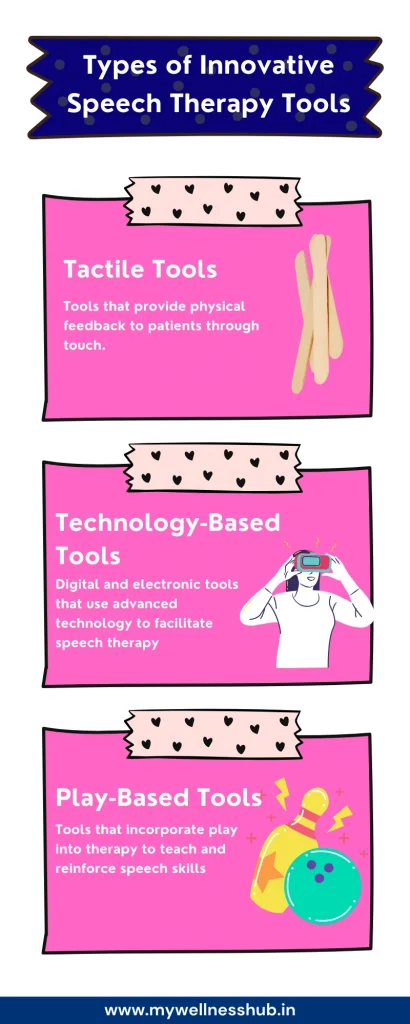Speech Therapy Games and Tools: Fun Way to Improve Speaking
Last Updated: May 17, 2024
Speech therapy, a crucial field dedicated to resolving communication disorders, has undergone remarkable transformations over the years. Historically, therapy was primarily reliant on traditional methods like repetition exercises and auditory mimicry to correct speech impairments. These techniques, while foundational, often require a high degree of repetition and could be mentally taxing for both therapists and clients.
In recent years, however, we’ve witnessed an exciting evolution in the tools available for speech therapy. Innovations in technology and tool design have introduced a new era of therapy tools that not only enhance therapeutic outcomes but also make the process far more engaging for participants. These innovative tools incorporate tactile, visual, and digital elements, transforming traditional speech therapy into a more dynamic and interactive practice.
The Role of Innovative Tools in Speech Therapy
Enhancing Diagnostic Accuracy
The precision of diagnosing speech disorders significantly impacts the success of subsequent therapies. Innovative tools like laryngeal video stroboscopy and audio meters have revolutionized how specialists assess and diagnose these conditions. Laryngeal videostroboscopy, for example, uses a fiberoptic camera to visually inspect the vocal cords’ movement during speech. This allows therapists to observe subtle abnormalities in vocal cord function that could affect a person’s ability to speak clearly, which might not be detectable through traditional examination methods.
Traditional vs. Innovative Speech Therapy Tools
| Aspect | Traditional Tools | Innovative Tools |
|---|---|---|
| Cost | Generally lower; often,one-time purchases for physical items like flashcards and mirrors. | Higher initial costs are due to technology integration but often lead to longer-term savings through enhanced efficiency and effectiveness. |
| Effectiveness | Effective with consistent and prolonged use depends heavily on the skill of the therapist. | Highly effective with potentially faster results; automated features and personalized settings enhance therapeutic outcomes. |
| Engagement Level | Moderate; can be repetitive and less appealing over time. | High interactive and dynamic elements keep patients engaged and motivated. |
| Types of Feedback | Primarily auditory and some visual feedback through mirrors or manual demonstrations. | Comprehensive feedback, including auditory, visual, and tactile, through digital displays, interactive software, and sensory tools. |
From Assessment to Intervention
Innovative tools in speech therapy span three main categories: assessment, intervention, and technology-based tools, each playing a crucial role in the therapeutic journey.
Assessment Tools:
These are fundamental in establishing a baseline and understanding the specific needs of each client. Tools like language sampling, where a therapist analyzes aspects of the patient’s spontaneous speech, provide invaluable insights into their natural language use in real-world settings. This method helps identify specific areas that need targeted interventions.
Intervention Tools:
Once the assessment phase pinpoints the challenges, intervention tools come into play. Bite blocks and jaw exercises, for example, are used to strengthen oral muscles and improve articulation. These tools are designed to be both functional and engaging, ensuring that patients remain motivated throughout their therapy sessions.
Also Read: Oral Motor Exercises: Key to Better Speech
Technology-Based Tools:
These include a range of digital resources, from interactive applications to virtual reality environments, that make therapy sessions more dynamic and interactive. These tools not only enhance the learning experience but also keep patients, especially younger ones, engaged and enthusiastic about their therapy sessions.
By seamlessly integrating these tools from assessment through intervention, speech therapists can offer more comprehensive and effective treatment plans. The utilization of these innovative tools facilitates a more engaging and responsive therapy experience, ensuring that each session is not only productive but also enjoyable.
Types of Innovative Tools and Their Benefits

Tactile and Kinesthetic Tools
In the realm of speech therapy, tactile and kinesthetic tools play an indispensable role by providing physical guidance and tactile feedback. These tools are designed to enhance the sensory experience of the users, thereby facilitating more effective learning and practice of speech techniques.
For instance, the Talktools Straw Kit is a revolutionary toolset that incorporates a hierarchy of straws of varying diameters and lengths. This structured approach helps individuals improve their breath control, which is crucial for speech production. By practicing with these straws, users learn to modulate their breath, leading to clearer and more controlled speech.
Similarly, Chewy Tubes offers a simple yet effective solution for those needing to strengthen their jaw muscles. These tubes are designed to provide a resilient, non-food, chewable surface for practicing biting and chewing skills, which are vital for speech clarity. The tactile nature of Chewy Tubes helps users with proprioceptive input to their jaw, which can be particularly beneficial for children developing early speech and language skills.
These tactile tools not only support the physical aspects of speech therapy but also make the process more interactive and engaging, thereby enhancing the overall therapy experience.
Also read: Boosting Toddler Development: Occupational Therapy Insights
Technology-Enhanced Tools
In today’s digital age, technology-enhanced tools are transforming speech therapy into an interactive and fun experience. These tools leverage the latest technology to provide cutting-edge benefits that traditional methods could not offer.
Virtual reality (VR) software, for example, immerses users in a controlled and interactive environment where they can practice speech and language skills in a variety of simulated scenarios. This immersive experience is not only more engaging but also allows for a safe space to practice social interactions and public speaking.
Also Read: Revolutionize Speech Therapy with Wellness Hub’s Tele Basics
Play-Based Therapy Tools
Play-based therapy tools are particularly effective in making speech therapy engaging and accessible for children. These tools incorporate elements of play to teach and reinforce speech skills in a natural and enjoyable way.
Stacking blocks, for example, can be used to encourage speech as children name colors, shapes, and sizes while building. This not only helps in vocabulary building but also in the development of fine motor skills and cognitive abilities.
Flashcards are another simple yet powerful tool. By integrating images with words, flashcards stimulate visual learning and help children associate sounds with visual cues. This method enhances memory retention and aids in the faster recall of words and phrases.
By incorporating these playful yet purposeful tools into therapy sessions, therapists can create a positive and stimulating learning environment that fosters effective communication skills in children.
Implementing Tools in Your Practice
Integrating innovative tools into speech therapy requires thoughtful consideration of each patient’s unique needs. Here’s how therapists can effectively incorporate these tools:
- Assessment Before Implementation: Begin with a comprehensive assessment to determine which tools are most appropriate for the patient’s specific challenges and goals.
- Customization and Adaptation: Customize the use of tools to fit individual needs. For example, adjusting the difficulty level of interactive apps or choosing specific types of tactile tools based on the patient’s sensory preferences.
- Integration with Traditional Methods: Combine innovative tools with traditional speech therapy techniques. This blended approach can cater to a wider range of learning styles and reinforce different aspects of language learning.
- Regular Monitoring and Adjustment: Continuously monitor the patient’s progress and adjust tool usage accordingly. This ensures the therapy remains effective and responsive to the patient’s evolving needs.
- Training and Education: Stay informed about the latest tools and techniques by participating in professional development. This knowledge allows for the ongoing enhancement of therapy practices.
The Future of Speech Therapy Tools
As we look toward the future, the field of speech therapy is poised to undergo even more transformative changes thanks to emerging tools and technologies. These advancements promise not only to enhance the efficacy of treatments but also to make speech therapy more accessible and personalized.
Emerging Tools and Technologies
Artificial Intelligence (AI) and Machine Learning:
AI is beginning to play a significant role in speech therapy by providing more personalized treatment plans and real-time feedback. AI-powered systems can analyze speech patterns more thoroughly and suggest specific exercises to target weak areas, potentially accelerating progress.
Augmented Reality (AR) and Virtual Reality (VR):
AR and VR technologies are set to expand their influence in speech therapy. These tools can simulate real-life interactions and social scenarios, offering a safe space for patients to practice and improve their communication skills. For example, a VR setup could simulate a classroom, social gathering, or job interview, allowing individuals to practice relevant social cues and conversation strategies.
Wearable Technology:
Devices like smartwatches and wearable biosensors are expected to monitor speech and vocal patterns throughout the day. This constant monitoring can provide invaluable data that therapists can use to adjust therapy in real time, ensuring that patients continuously work on their speech in their everyday environment.
Impact on Patient Outcomes
The integration of these technologies could drastically enhance patient outcomes in several ways:
- Increased Accessibility: With digital and remote therapy options, more individuals can access high-quality speech therapy services, regardless of geographical limitations.
- Enhanced Motivation and Engagement: Gamification of therapy sessions through interactive and immersive tech tools can lead to higher levels of patient engagement and motivation.
- Faster Improvement: The ability to collect and analyze large amounts of data in real time means that therapy can be adjusted more swiftly and effectively, potentially speeding up the improvement process.
- Greater Customization: Advanced tools will allow for more personalized therapy tailored to the specific nuances of each patient’s speech patterns and needs.
Conclusion
The advancements in therapy techniques have transformed how we approach and enhance communication skills, making each session more impactful and rewarding. With these progressive methods, therapy becomes not only more accessible but also more customized to meet individual needs, speeding up the progress and enhancing the overall experience.
At Wellness Hub, we are dedicated to providing top-tier support and resources to our clients and professionals in the field. Whether you’re looking for guidance on general therapy practices or need specific help with communication challenges, Wellness Hub is here to assist. Explore our website to access a wealth of information, or contact us directly for tailored support.
Frequently Asked Questions:
1. What are innovative tools in speech therapy?
Innovative tools in speech therapy refer to the latest technologies and devices designed to enhance the effectiveness of speech therapy sessions. These can include digital applications, virtual reality environments, tactile devices, and other interactive tools that help improve communication skills in a more engaging and personalized manner.
2. How do innovative tools improve speech therapy?
Innovative tools make speech therapy sessions more interactive, engaging, and tailored to individual needs. They provide real-time feedback, allow for more precise diagnosis, and help therapists design customized treatment plans that can lead to faster and more significant improvements in speech and communication skills.
3. Who can benefit from using innovative tools in speech therapy?
Anyone undergoing speech therapy can benefit from these innovative tools, including children with speech delays, adults with communication difficulties, and individuals recovering from medical conditions affecting speech. These tools are designed to cater to a wide range of ages and specific needs.
4. Can innovative speech therapy tools be used at home?
Yes, many innovative speech therapy tools are designed for both clinical and home use. These tools often come with user-friendly interfaces and instructions that make it easy for patients and families to incorporate them into regular practice at home, enhancing the therapy process.
5. How do I choose the right speech therapy tools for my needs?
Choosing the right speech therapy tools depends on your specific needs and goals. It is important to consult with a professional speech therapist who can assess your or your child’s individual challenges and recommend the most effective tools based on those needs.
6. What should I expect when using innovative tools in speech therapy sessions?
When using innovative tools in speech therapy, you can expect more dynamic and customized sessions. These tools provide engaging ways to practice speech techniques and help track your progress over time, ensuring that each session contributes effectively towards achieving your communication goals.
7. Are innovative speech therapy tools suitable for all age groups?
Yes, innovative speech therapy tools are designed to cater to a wide range of age groups, from toddlers to adults. The tools are often adjustable to suit different skill levels and age-specific needs, making them versatile for various stages of language development.
8. What advancements can we expect in speech therapy tools in the future?
The future of speech therapy tools is likely to see further integration of artificial intelligence, augmented and virtual reality, and more sophisticated data analytics. These advancements will enhance the customization of therapy, making it even more targeted and effective for individual needs.
9. How do virtual reality tools aid in speech therapy?
Virtual reality tools in speech therapy immerse patients in interactive environments where they can practice social skills, pronunciation, and other communication tasks in a controlled, realistic setting. This technology helps users practice and improve their speech and language skills in a variety of simulated social situations.
10. Can innovative tools help with online speech therapy sessions?
Absolutely. Innovative tools are particularly useful in online speech therapy sessions as they can enhance the interaction between the therapist and the patient remotely. Tools such as digital apps and web-based programs allow for real-time feedback, engaging activities, and consistent tracking of progress, all of which are crucial for effective therapy from a distance.
About the Author:
Anuradha Karanam
Speech-language pathologist (7+ years of experience)
Anuradha Karanam is a skilled speech-language pathologist with over 6 years of experience. Fluent in Tamil, Telugu, Hindi, and English, she specializes in parent counseling, speech sound disorders, fluency assessment, and speech-language evaluations. Anuradha excels at working with children with developmental disorders, offering creative and effective therapy programs. Currently, at Wellness Hub, she holds a BASLP degree and is registered with the RCI (CRR No A85500). Her patience, ambition, and dedication make her a trusted expert in her field.
Book your Free Consultation Today
Parent/Caregiver Info:
Client’s Details:
* Error Message









